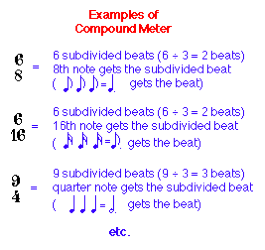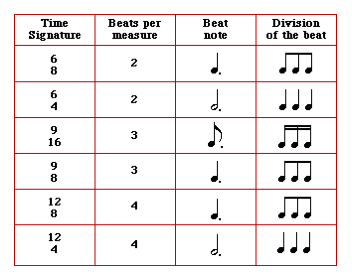| 14 |
Compound Meter |
| Compound meter is used to notate music that has three instead of two subdivisions per beat. An example is the familiar tune: "Row, Row, Row Your Boat". |
|||||
|
||||||
You will probably find yourself tapping or counting in a pattern like this: 1 . . . 2 . . . 1 . . . 2 . . . 1 . . . 2 . . . You probably hear this example in terms of two-beat groupings. However, when you got to "mer-ri-ly, mer-ri-ly, mer-ri-ly, mer-ri-ly, ..." you divided each beat into three notes instead of the normal two. In fact, the entire piece has three subdivisions per beat. (1 - 2 - 3... 2 - 2 - 3... 1 - 2 - 3... 2 - 2 - 3... ) In compound meter, each beat is normally subdivided into three parts, and the note receiving the beat is always a dotted note value (i.e. a dotted quarter, a dotted half, a dotted eight, etc.) This is because a dotted note value may always be easily divided into three equal notes (i.e. a dotted quarter = 3 eighth notes). Because time signatures consist of whole numbers only, the numbers in a compound meter time signature indicate the number of subdivided values. In compound meter: The top number indicates the number of subdivided beats per measure. The bottom number indicates the rhythmic note value that receives the subdivided beat. Because the subdivision is always by three, the top number in a compound time signature will always be a multiple of three: 6, 9, or 12 being the most common. As an example, a meter with 3 beats per measure (each subdivided into 3 parts: 3 x 3 = 9) with the dotted quarter note (or subdivided into three eighth notes) receiving the beat is called "9 - 8" time, and is notated with a "9" in the top number and a "8" in the lower number. |
|||||
|
||||||
In compound meter, the number of beats per measure is always the top number divided by three. So a "6" in the top number means that there are "six divided by three" beats, or two beats per measure. |
|||||
|
||||||


